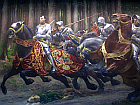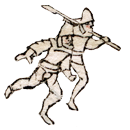History > The Battle of Morat 1476
Tourist recommendations for Morat 1476
The battle of Morat and the Burgundian Wars were of prime importance to all European courts. From Matthias Corvinus in Hungary to the Duke of Milan to the French King Louis XI, connections to the campaign abound. The following recommendations refer to Swiss sights. Another article on the Burgundian and Lorraine ones are certainly merited. Suffice to say that Dijon, capital of Burgundy, Nancy, the site of Charles the Bold's last battle (commemorated in Eugène Delacroix' painting exhibited in Nancy's Musée des beaux-arts) and Bruges, the site of Charles the Bold's burial place are prime places to visit. The French, Flemish and Habsburg connections make Paris, Bruxelles and Vienna further important stops.
Sights in and around Morat
The Morat ossuary (Beinhaus) in which the bones of the fallen soldiers had been collected has been destroyed by the French invading army in 1798. The ossuary was built in 1506, replacing a chapel dating from 1478. In the ossuary's place stands an obelisk [LOC] that commemorates the battle. It is located in Meyriez, to the south of the city of Morat. Thus, the main monument to the battle stands far away from the actual place of the battle. Instead, it was a convenient place to rebury the remains. Erected in 1822, the obelisk's inscription states:
VictoriamOn the wooden commanding hill of Bois Domingue [LOC] stood Charles the Bold's wooden tent and enclosed camp. It offered an excellent panoramic view of the city of Morat. Charles traveled in style and luxury. Despite having lost his most precious tents and camp utensils after the battle of Grandson, his camp at Morat had to be a sight to behold. Today, it offers a wooden shelter and an explanation of the battle of Morat.
XXII Jun. MCCCCLXXVI
Patrum Concordia
Partam
Novo Signat Lapide
Republica Friburg.
MDCCCXXII.
The wonderful little city of Morat [LOC] preserved its medieval battlements and its castle. The castle, used by public administration, is generally not accessible for tourists. The battlements, made out of stone and wood, are open for exploration. Watch out toward the north-east where the Savoyards assaulted the city. Look out to the east where the Swiss relief forces approached. Watch southwards towards Charles headquarters on Bois Domingue. Turn around and expect to see supply boats approaching on Lake Morat. Plan to spend some time strolling through the lovely alleys of the city. Please find further information at the Murten tourism website.
Just outside of the old city of Morat, next to the castle, lies the Murten Museum [LOC]. An excellent multilingual mulitmedia presentation provides an overview of the battle and the Burgundian Wars. Highlights of the museum are guns from the Burgunderbeute as well as two life-size replicas of a disillusioned Burgundian soldier and his wife.
Grandson and Lake Neuchâtel
Sixty kilometers from Morat lies Grandson [LOC], the city that gave its name to Charles the Bold's first battle with the Swiss, although the actual battlefield lies near Concise well to the north-east of the little city. The Castle of Grandson houses a spectacular collection of armor and weapons and is well worth a visit.
The battle of Grandson's actual battlefield [LOC] above Concise, eight kilometers from Grandson, is underwhelming. The battle schematic on the commemorative stone offers a very poor representation of how the action took place. At least, the Swiss position gives a panoramic view of the battlefield but requires imagination and knowledge about the battle's events. The subtle depreciation of the historic battle marks the full shift to the French part of the language divide. Being part of the losing team does not engender enthusiam for the battle's history.
Forty-two kilometers further north-east on Lake Biel lies La Neuveville. Its Musée d'Art et d'Histoire de La Neuveville [LOC] houses an outstanding collection of Burgundian artillery pieces. Seven canons and three bombards from the actual Burgunderbeute. [cont.]
Museums and Sights around Switzerland
The prizes seized from Charles the Bold at Grandson and Morat were so lavish that most historical museums in Switzerland own pieces of it in their collections. It is just a matter of a keen eye or a friendly question.
Starting with Switzerland's capital, Berne, its Historical Museum of Berne [LOC] has a rich collection of objects. Among its highlights are the Thousand Flowers tapestry (Tausendblumenteppich) and other Burgundian tapestries and banners. At present, the fantastic Murtenpanorama can only be visited virtually. In the near future, it will be housed adjacent to the historical museum. Don't miss Adrian Bubenberg's statue [LOC] in the city center. He commanded the Bernese garrison during the siege of Morat. His castle of Spiez is also listed below.
Following the Aare river upstream one arrives at the city of Thun. Its castle museum [LOC] devotes a full room to the Burgundian Wars. Highlights are original flags from Burgundy and Thun as well as weapons. The visit can be combined with one to the Castle of Oberhofen [LOC] nearby, owned by Niklaus von Scharnachthal, commander of the Bernese forces at Morat. Hopefully, they kept some of the 2009 special exhibition about his life in the castle. On the other side of Lake Thun lies Castle Spiez [LOC], owned by Adrian von Bubenberg already mentioned above. In the castle garden, one finds another statue of him. To complete the tour of castles of the Swiss commanders, it is necessary to mention Hallwyl Castle [LOC], although exhibits relating to Hans von Hallwyl are scarce.
 It is quite a curvy drive through nowhere to arrive at Moudon which hosts the Musée Eugène Burnand [LOC]. Eugène Burnand (1850-1921) was a local painter of cows and biblical scenes. Among his best works are wonderful individual and expressive portraits of Allied soldiers of the First World War done in Paris. His large painting The Flight of Charles the Bold is equally vivid and dwarfs the museum's small room.
It is quite a curvy drive through nowhere to arrive at Moudon which hosts the Musée Eugène Burnand [LOC]. Eugène Burnand (1850-1921) was a local painter of cows and biblical scenes. Among his best works are wonderful individual and expressive portraits of Allied soldiers of the First World War done in Paris. His large painting The Flight of Charles the Bold is equally vivid and dwarfs the museum's small room.
In Zurich, we find another statue of one of the Swiss commanders, Hans Waldmann [LOC]. Commander of the Gewalthaufen at Morat, his mayorship of Zurich later turned into a corrupt near-dictatorship, until he tried to prevent the Zurich dogs from barking too much. This was the spark that led to his downfall and decapitation. Today, his statue is exposed to relentless pigeon attacks.
The current crop of curators at the Swiss National Museum [LOC] in Zurich try to remove and hide away all things military (to the attic, actually). Out of their own didactical ineptitude to present the history of Switzerland (currently incomprehensible to foreign visitors), they were forced to return some of the removed popular but military themed exhibits. Among these was the magnificent and unique 9.000 piece flat tin soldiers diorama of the battle of Morat which was moved from its location in the basement (sic!) to a prominent (but narratively non-integrated) place on the first floor.
Written by Jean-Claude Brunner, November 2011.

